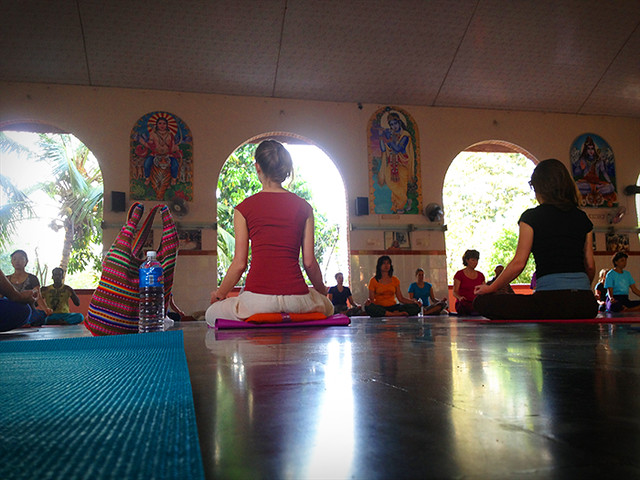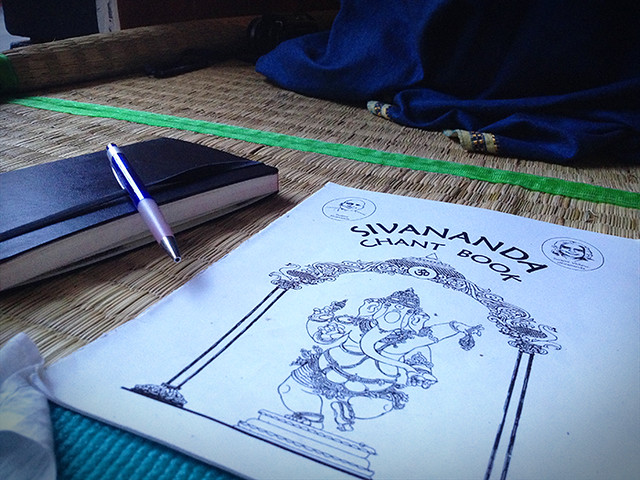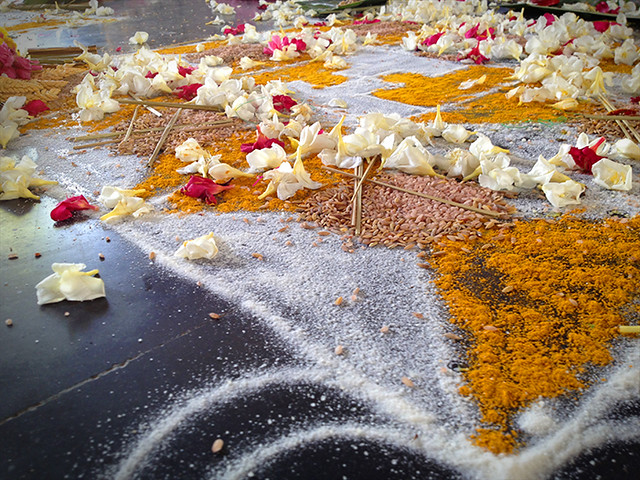
Dawn is breaking, cool and pastel blue. Somewhere in the distance across the jungle valley, a relentless tonal recording has been echoing through the treetops for at least an hour. Blaring horns blend with unfamiliar tropical bird squawks and what sounds like a harrumphing call of a hippo, although I’m fairly certain there are no such creatures here. I’m in the middle of nowhere tropical India, at Sivananda yoga ashram, nestled beneath peaceful lush green palms in the Communist state of Kerala.
I feel like a statue in the stillness, a living pillar of non-movement. And it is painful. I wonder if the other 100 or so sitting yogis in the meditation hall feel the same.
Eyes closed, observing my own discomfort, I watch my mind react to the creeping physical numbness that can accompany extended periods of non-movement. Why is it always such a battle to make the unconscious conscious? It is the unconscious that tells me to take immediate action––change position! But it is the conscious––feeble and weak––that is attempting to cultivate the awareness that wills my body to remain immobile in meditation. I try to observe, to ignore my screaming mind, to stay still and wait it out.
Alas, the mind wins this time. I unfurl my legs and stretch.
Our teacher’s chosen topic of discussion today is what he refers to as one of the biggest challenges in life: the mind. Remember, you are not your mind, he says.

The mind can be our best friend or our worst enemy.
It is the mind that tells us never ending stories. It is the mind that expertly weaves a web of judgements, prejudices, and preconceived notions until we’re so wrapped up in the rambling narrative echo in our head that we can’t help but believe it as truth.
Our teacher says that the practice of yoga polishes our inner mirror allowing us to see the reflection of our true self. In this way, we can better understand the stories of the mind.
This is why yoga is useful: it is a systematized way to “control” the mind through awareness, to find the truth of who you really are by quieting the mind’s ceaseless chatter and by finding physical and mental harmony between body and soul. It is an ongoing practice, a constant search to touch what is true.

This is how each day begins at the Sivananda yoga ashram:
A wake-up bell at 5:30AM before dawn, then almost two hours of required satsang, which includes silent sitting meditation, chanting, and a brief lecture on philosophical topics. Once the sun has risen, we roll up our mats and head to the jungle garden for steaming hot chai tea.
Next, it’s time for two hours of yoga. All this before eating any sort of meal.
This pattern repeats itself in reverse in the afternoon and onward into the evening. In between, after lunch, we are obligated to do an hour or two of seva, or volunteer work. It’s a good reminder that we are a living part of a larger community.
***
Ashram life isn’t for everyone, but maybe that’s the appeal.

While I feel physically energized after four hours of daily yoga, I admit that at first it’s not easy. Sleep deprivation catches up with me quickly, and the sparse meals trigger a persistent craving for an Indian thali and steaming fresh naan.
Spending time at an Indian ashram require you to adapt to less. It’s part of the reason so many people come; it’s a complete meditation. The ashram environment offers space and time to unplug entirely, and unravel mentally and physically.
One of the benefits of all this is that I begin to see things from another perspective. It’s amazing how much easier it is to appreciate the basics only after they are taken away. Hot water showers, toilet paper, spoons––in my normal life these things are hardly even noticed. In ashram life, they are greatly missed.
At the ashram I’m reminded: nothing can exist without its opposite.
Dedicating time for peace and reflection by visiting an Indian yoga ashram is well worth it. Of course, the challenge upon leaving is learning how to integrate all that is gained from ashram life back into your real-world life.
